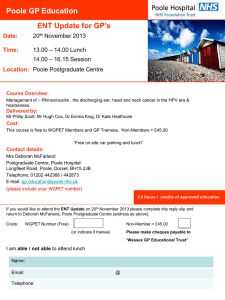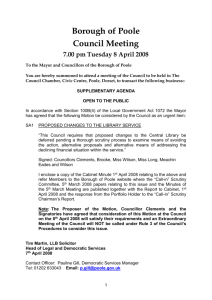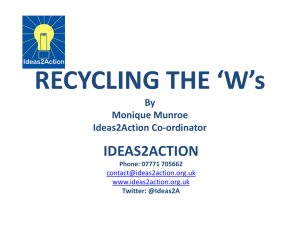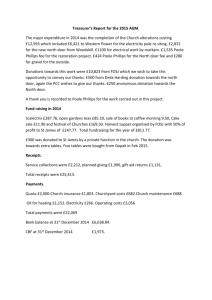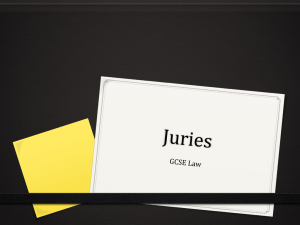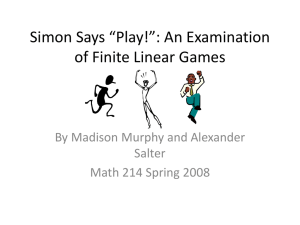Expanded Lit Review and Rationale
advertisement
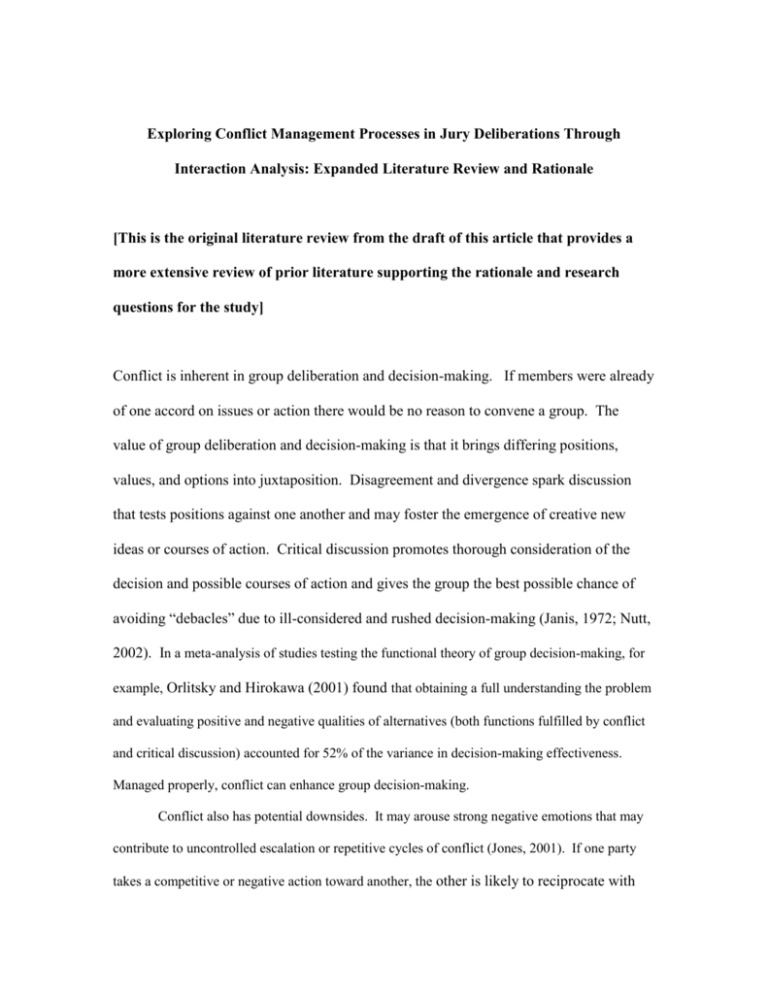
Exploring Conflict Management Processes in Jury Deliberations Through Interaction Analysis: Expanded Literature Review and Rationale [This is the original literature review from the draft of this article that provides a more extensive review of prior literature supporting the rationale and research questions for the study] Conflict is inherent in group deliberation and decision-making. If members were already of one accord on issues or action there would be no reason to convene a group. The value of group deliberation and decision-making is that it brings differing positions, values, and options into juxtaposition. Disagreement and divergence spark discussion that tests positions against one another and may foster the emergence of creative new ideas or courses of action. Critical discussion promotes thorough consideration of the decision and possible courses of action and gives the group the best possible chance of avoiding “debacles” due to ill-considered and rushed decision-making (Janis, 1972; Nutt, 2002). In a meta-analysis of studies testing the functional theory of group decision-making, for example, Orlitsky and Hirokawa (2001) found that obtaining a full understanding the problem and evaluating positive and negative qualities of alternatives (both functions fulfilled by conflict and critical discussion) accounted for 52% of the variance in decision-making effectiveness. Managed properly, conflict can enhance group decision-making. Conflict also has potential downsides. It may arouse strong negative emotions that may contribute to uncontrolled escalation or repetitive cycles of conflict (Jones, 2001). If one party takes a competitive or negative action toward another, the other is likely to reciprocate with competitive actions of his or her own (Burgoon et al., 1995; Caughlin & Vangelisti, 2006). Leary (1957) described an “interpersonal reflex” to respond to hostile behavior with hostile behavior, which resulted in the emotional escalation of conflicts. In studies of family groups Vucinich (1984; 1990; see also Messman & Canary, 1998) reported that opposition, complaints, defensiveness, and expressions of negative affect are often responded to in kind. This tendency to reciprocate tends to set up cycles of competitive behavior which may escalate and impede the group’s ability to evaluate ideas and options critically. Instead, decisions are made by forcing or, alternatively, are not made at all as the group ends in impasse. Nowhere more important is critical consideration of evidence, interpretations, and alternative points of view than in the jury. And nowhere more important is avoiding personalized, negative conflict that substitutes trying to win points for measured judgment. The archetypal illustration of effective jury deliberation is Twelve Angry Men, in which Jimmy Stewart’s lone holdout juror wins acquittal for an innocent man through a combination of resolute fortitude and rigorous inquiry and argument. However, it is not clear how often this constructive management of conflict prevails in juries. As Sunwolf (2007) observes, “Real world jury deliberations remain a tantalizing puzzle for lawyers, judges, consultants, and researchers” (p. 13). To date there have been few studies of the processes by which real world juries manage conflict. The purpose of this study is to explore conflict management processes in two deliberations by a jury, one which decided the case and the second the penalty phase of the trial. Through microlevel analysis of transcripts of deliberations, it derives a map of the ebb and flow of conflict and conflict management processes during the two sessions. Analysis of these maps will focus on several questions, including the nature of conflict management in the sessions, temporal patterns of conflict management, how the two sessions differ in conflict handling, and how conflict management processes shaped the deliberations in the two sessions. The study will contribute to our understanding of juries, but it also will contribute to the larger literature on group decision making and conflict management, which has only a few rigorous studies of conflict management in real world groups. In the next section we review the literature on conflict management in real world groups and draw out several research questions that will guide the study. Following this, we describe the methodology. The third section presents the results of the analysis. Finally we discuss the implications of the results for our understanding of juries and of groups in general. Literature Review and Research Questions Conflict Management and Group Outcomes Both laboratory and field studies suggest that the impact of conflict on group outcomes such as decision quality, consensus, and satisfaction with the decision depends on how the conflict is handled (Nicotera & Dorsey, 2006; Poole & Garner, 2006). Experiments by Wall, Galanes, and Love (1987) and by Sambamurthy and Poole (1992) provide evidence that surfacing conflict and confronting issues through open communication increased the quality of outcomes, the group’s ability to achieve consensus, and satisfaction with the decision. Several laboratory studies of negotiations indicate that collaborative approaches promote mutually beneficial outcomes (Brett, Shapiro, and Lytle 1998; deDreu, Weingart, & Kwon 2000; Weingart, Hyder, & Prietula 1996). A number of recent studies of real world groups have found that conflicts that were (a) focused on substantive issues and (b) effectively resolved were positively related to group and individual performance (Poole & Garner, 2006). This effect was more pronounced in groups with high levels of interdependence (Jehn, 1995; Janssen, van de Vliert & Veenstra, 1999), perhaps because conflicts interfere with group effectiveness to a greater extent when there is greater need for coordination. Alper, Tjosvold, and Law (2000) found that self-managed teams that took a cooperative approach to conflict—characterized by an emphasis on understanding all points of view, orientation to joint benefit, and finding a solution acceptable to all—had higher levels of effectiveness than those that were characterized by a win-lose orientation. In a study of new product development teams in organizations, Lovelace, Shapiro, and Weingart (2001) found that collaborative communication—as would occur in compromising and problem-solving conflict management styles—was associated with a team’s innovativeness. Kuhn and Poole (2000) studied quality management teams and found that those that developed patterns of collaborative conflict management in early meetings later made more effective decisions than those that developed patterns of avoiding or competing conflict management styles. Tjosvold’s (1993; Tjosvold, Wedley, & Field, 1986) model of constructive controversy specifies how conflict handling relates to group effectiveness and member satisfaction. This model posits that open confrontation of issues, emphasis on achieving understanding among members, critical discussion of different points of view, a focus on mutual benefit, and integration of member positions increases group effectiveness and enhances group climate. These form a “virtuous circle,” in which constructive controversy creates an open and trusting climate in the group, which in turn encourages members to confront decisions constructively, further enhancing climate, and so on. Tjosvold et al. (1986) found that the degree to which workgroups engaged in constructive controversy accounted for 40% of the variance in decision-making effectiveness. As Sunwolf (2007) describes juries, however, they are not likely to enact these salutary approaches to conflict. Sunwolf argues that juries are likely to adopt several faulty norms that are likely to result in ineffective conflict management. First, juries often tend to give the foreperson excessive power to set the discussion agenda, to decide when discussion should occur and to manage the discussion. If the foreperson leans to one side of an issue, he or she can use this power to slant the discussion towards the preferred direction. Second, juries may assume that “individual or small subgroup positions are presumptively less worthy than positions supported by many or by the majority” (p. 273). This tends to preclude the type of thorough, constructive discussion of all sides of the conflicts. Third, juries sometimes regard “name-calling, yelling, and coercion” as appropriate influence measures. Fourth, juries may assume that “conflict over trial issues during deliberation will trigger relational/social conflict between jurors,” leading them to avoid conflict and attempt to resolve it as soon as possible, without careful consideration of the merits of the various positions. Finally, juries often assume that they must reach a verdict and if they cannot, then they have failed in their duty as jurors. This is reinforced by the judicial system’s practice of necessitating a retrial in the case of a hung jury (Sunwolf, 2007, section 14.2d). As a result, when impasse seems to be occurring, jurors in the majority are more likely to try to force those in the minority to fall in behind them. This reinforces less effective responses to conflict and militates against critical consideration of evidence, interpretations, and alternative points of view that is important to effective decision-making. Whether these norms or more salutary ones prevail depends on the process of conflict management over the course of jury deliberations. Norms are invoked, enacted, and enforced via interaction processes. Understanding jury deliberative processes in juries and how they contribute to or impede conflict management is critical to assessing the impact of conflict on jury decision-making. Communication Processes in Conflict Management Most of the studies just reviewed conceptualize conflict in general terms, focusing on synoptic pictures of conflict management styles, such as integrating, competing, and constructive controversy. They portray conflict management as a process that is for the most part consistent throughout the discussion. However, we know from studies that have tracked the process of group decision making in greater detail that the actual path to a decision is often quite complex, with relatively few groups passing through the simple, logical sequence of phases posited by ideal decision-making models (Poole & Baldwin, 1996). Instead, many groups follow more complex paths characterized by multiple short phases in which the group may reopen previous issues, revisit previous phases, take breaks and have to restart, become sidetracked by conflict or by unforeseen problems, and go off on tangents from which it must be recalled. For example, a group may discuss the problem, then move to solutions, then move back to reconsider the nature of the problem, then move to solutions, then to a period of off-topic joking, then back to the problem and so on, in a process in which progress resembles reach-testing as described by Scheidel and Crowell (1964). Still other groups start by discussing solutions and only later (if at all) consider the problem or issue the solutions are meant to address. Poole and Roth (1989) found more than ten distinct decision paths, some relatively simple and some quite complex, in a sample of 47 groups. Sambamurthy and Poole (1992) identified fifteen distinct patterns of conflict management processes that fell into four major types in a sample of 54 groups. This variability suggests that deeper understanding of how conflict management figures in jury decision-making will come from closer analysis of group processes (Poole, 2007; Poole, Van de Ven, Dooley & Holmes, 2000). Such analysis will provide insight into the character of conflict management at the local level, and larger scale patterns can be identified by moving from the ground up. This approach explores the impact of local processes on the emergence of large scale conflict management practices. Direct analysis of group process also enables us to avoid two potential problems in studies of conflict in real world groups (Poole & Garner, 2006). First, the research designs of studies of conflict in RWGs typically rely on participants’ self-reports of their attitudes and behavior. This yields a synoptic view of how the conflict was managed that is likely to elide important details of the actual process. Moreover, as Poole and Garner (2006, p. 278) note, is also raises “the possibility that implicit theories about how ‘effective’ groups handle conflict have influenced subject responses.” A second problem with most studies of conflict in RWGs is that they are cross-sectional in nature, and hence cannot establish causal effects that conflict management behavior may have on outcomes. Kuhn and Poole’s (2000) study provided some evidence for a causal link between conflict management style and decision making effectiveness, and the lab studies cited previously support it as well, but more evidence from field research is certainly needed. An Approach to the Study of Conflict Processes What criteria should an adequate approach for the study of conflict processes in real world groups satisfy? First, it should capture the interactive nature of the conflict at the microlevel and enable microlevel patterns to be established. Through these microlevel processes, parties constitute the conflict and enact conflict management. An adequate approach should, second, support the identification of larger units, such as episodes and phases of conflict and other activities. Microlevel patterns build up larger structures and patterns that constitute the overall “direction” of the discussion and move conflict management in productive or destructive directions (Folger, Poole, & Stutman, 2009). The particular sequence in which episodes or phases occur in the discussion constitute the group’s overall approach to conflict management, and can be characterized synoptically as particular styles of conflict management at the group level. A third criterion an adequate approach would meet is that it should not presume that the conflict and its management will follow a set of predetermined episodes or phases. To account for the variability of conflict processes, the method must follow the flow of the conflict through whatever patterns parties enact. To satisfy these criteria we employed the following general approach: We utilized Group Working Relationships Coding System (GWRCS; Poole, 1983; Poole & Roth, 1989) to code conflict process. The GWRCS encodes patterns of interaction among group members during short segments of group discussion, rather than single acts by individuals, and thus centers on identification of microlevel interaction patterns. Analysis of the GWRCS data focused on identification of microlevel patterns of working relationships among members using Markov modeling (Poole et al., 2000, Ch. 6). Markov models reveal the local interdependencies among the various types of working relationships. To characterize larger units within the group discussion we employed flexible phase mapping, a technique that delimits functionally similar phases of the discussion (Poole et al., 2000, Ch. 7). The technique does not impose any particular length on the phases it identifies, but flexibly divides the discussion into phases of different lengths according to the function the phase serves. The result is a temporal map of the phases in the discussion that can be used to characterize the overall approach the group employs in dealing with conflict. More specifics on the methods will be presented in the next section; here we will focus on general approach and construct definition. The observational system we will employ to describe conflict management processes is based on a normative model of conflict management presented by Walton (1969; Folger, Poole, & Stutman, 2009). This model describes a two phase model of effective conflict management: during the initial phase, differentiation, parties air positions, define issues, and discuss differences, and during the second phase, integration, parties work out a resolution that takes into account their differing needs and positions. If differentiation is handled properly, parties learn about others’ positions, interests, and issues and develop an understanding that they are going to have to work with others to manage the conflict effectively. If integration is properly handled, parties develop solutions that take their joint concerns into account, develop commitment to accept and stick to the solution, and develop respect. If either the differentiation or integration phases are truncated or ineffectively executed, conflict management will be less effective. If differentiation is not adequate, parties’ do not develop an understanding of each other’s issues and problems and they may not be motivated to work together toward a resolution. As a result parties may not move to the integration phase and they may become stuck in continuing cycles of conflict. But even if differentiation is accomplished properly, integration may not be. In this case, subpar resolutions may result and parties may have little commitment to them. The two-phase normative model also implies two less desirable conflict management patterns (Folger et al., 2009). First, the parties may never surface conflict and thus fail to differentiate at all, that is, they may avoid and submerge the conflict. Second, parties may surface differences, but be unable to work together, in which case one party may force the other to accept his/her preferred option or one party may simply accede and give in to the other. Both of these approaches to managing conflict involve capitulation of one party and allow the group to move forward, but they are likely to lead to less positive outcomes than will moving through the two phases properly. Following Putnam and Wilson (1982; Folger et al., 2009) we can rank the three responses in terms of their degree of confrontiveness, which refers to the extent to which the parties openly deal with the conflict and resolve differences in their positions. On the confrontiveness scale, avoidance would be lowest, capitulation would be at an intermediate position (since the parties openly acknowledge the conflict), and integration would have the highest level of confrontiveness (since the parties are open about the conflict and try to work out solutions that take all positions into account). As will be described in the methods section, specific patterns of GWRCS codings can be used to identify avoidance, capitulation, and integration episodes in the jury discussions. Following Sambamurthy and Poole (1992), we can classify portions of a discussion or entire discussions into various conflict management types based on degree of confrontiveness.
